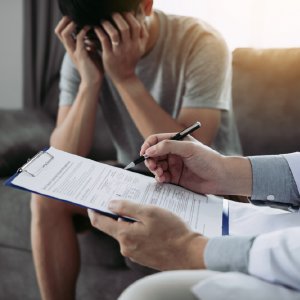The Need to Reduce Opioid Overprescribing

Our country is struggling with a serious opioid dependence problem, a problem that has been contributed to exorbitantly by excessive and ongoing overprescribing of opioid pain relievers. The use of opioid pain relievers as the primary method for addressing physical pain in patients began towards the end of the twentieth century, and since then the use of this methodology has skyrocketed.
We went from being a nation of almost no opioid use to being the top nation for opioid pain reliever use in the world, consuming close to seventy-five percent of the world’s supply of opioid pharmaceuticals every year. And we only maintain about five percent of the world's population in the U.S. There is something very wrong with that picture.
According to Dr. Barry R. Meisenberg, a physician in the department of medicine at the Anne Arundel Health System in Maryland:
“The prescriber’s role in generating and sustaining opioid abuse has been made clear by studies that link a practitioner’s prescribing patterns to a patient’s likelihood of long-term opioid dependence.”

And he’s right, too. While doctors' overprescribing of opioid pain relievers was not the only event that put us in the condition we are now in with opioid dependence, it was certainly one of the crucial factors. Going forward, our focus as communities has to be on reducing overprescribing rates, as we can be sure that this problem will take years to resolve if we leave it up to federal, governing bodies to address.
Politics Always Seems to Get Involved in Inhibiting Healthcare Advancement
Another factor that seems to influence things is that it always feels like every time we start to make a change in one direction for our health care, the political control of our country switches to the opposite side, and all of a sudden the government starts taking things in a different direction.
It's almost as though every governing body has four to eight years to “fix” the country's drug problem and other health issues. And as soon as the power of the governing body changes, our nation is taken in an entirely different direction. This is why we need more effective and more sensible solutions that bring about non-partisan, long-term change that is agreed upon and supported by all of us. It seems like the politicians need to put the good of the country and its citizens ahead of the good of their party or their political future.
We live in a country now where drug abuse is so common, where addiction is such a mainstay of every-day life, that this is something that we all together as a united people need to address. This problem will only get worse until our entire country decides to make a change for the better, and then makes a considerable effort in that direction to do so. So rather than looking at what the government is doing, rather than bickering about policy or arguing about incarceration versus treatment or debating about which political party has the best solution, let's instead look at how each individual American can do his or her part to reduce our country's drug problem, starting with reducing opioid overprescribing.
What Patients Can Do
First and foremost, we need to make a change in the prescribing issue on the doctor-to-patient level. This is not something that we want to leave up to others to fix for us. Patients in all states, cities and counties need to demand better care in the form of non-pharmacological approaches to pain relief. Or at the very least, if doctors must prescribe a pharmaceutical solution, they should not prescribe high-strength opioids. We need to get educated and understand the reason(s) the doctor prescribes a medication and what are the risks involved with taking the medication. This might take some time and research regarding the drug, the manufacturer of the drug and even the ethics and competency of the doctor. We need to explore and know our options and alternatives. When you see a doctor, he/she may be a trusted authority regarding illness or maladies, but you know your body better than anyone else. Educate yourself so you can give or not grant INFORMED CONSENT for your treatment. If you are not informed, how can you give CONSENT?

There are holistic and non-pharmacological solutions to pain relief. They do exist. Patients can take supplements and natural remedies like:
- Turmeric
- Willow Bark
- Cats Claw
- Valerian Root
- Ginger
- Magnesium
And that’s just half a dozen quick ideas for all-natural, addiction-free pain remedies. There are many others.
A New Law Acts as a Successful Action in California
Federal politics might be slow and painfully bureaucratic in addressing such critical health issues as opioid prescribing, but we may yet have more success at the State level. Case in point, the State of California just made some big changes in how they govern prescribing trends, hopefully making changes that will reduce risk and support ethical prescribing. Consider the following citation that discusses California’s change, quoted from an October 2nd news release from www.biospace.com:
“Starting today, California doctors will have to check a patient's prescription history before prescribing addictive opioids and other controlled substances…”“Starting today, California doctors will have to check a patient's prescription history before prescribing addictive opioids and other controlled substances. The legislation is the culmination of a years-long fight by families impacted by opioid abuse to mandate doctors consult a state prescription database in order to reduce opioid overprescribing and save lives.”
The article goes on to discuss the details of the new law, saying that:
“The new law requires prescribers to consult California's prescription drug monitoring database, the Controlled Substance Utilization Review and Evaluation System known as CURES, before prescribing Schedule II-IV controlled substances for the first time to a patient, and to check again once every four months if treatment continues.”As one can imagine, this is huge news. The tracking of prescribing trends has been available for decades, but it has always been voluntary. Every state now has a PDMP (Prescription Drug Monitoring Program) that offers a state-focused database on every patient in the state, which prescriptions they’ve gotten, what dosages they were on, etc. But for all this time, doctor’s use of such programs was voluntary.
Now, California has set a precedent by making it mandatory for doctors to examine such databases before they prescribe opioids. This will allow doctors to see if they are being “doctor shopped” by a patient who is trying to get medications for recreational or self-medicative purposes. It will also help doctors to better decide what not to put their patients on, based off what they've been prescribed in the past. California's example is one that all states should follow.
Moving Towards a Healthcare System that is Safe for Patients
Overprescribing of opioids has created a medical scenario in this nation where more than ten percent of our country’s addicts are hooked on legal pharmaceuticals, not illegal drugs. There is something very wrong with that picture.
Clearly, we cannot put our faith in the federal government to “solve” this problem for us. The opioid epidemic has raged while federal administrations run by both parties have been in charge. The problem has only gotten worse.
As we move forward into the next several years, we need instead to focus on state-level laws and regulations that can help us. And even more important than that, we as individual patients need to get educated and demand better care, and we need to once and for all say no to opioid pain relievers. It’s time we gave up on this failed initiative of twenty years ago. It’s time we moved towards addiction-free medical solutions.
Sources:
- https://www.healio.com/family-medicine/addiction/news/online/%7Bb3817a68-8bbe-4ef9-8c51-cbc7a68ce5a9%7D/multifocal-interventions-significantly-reduce-opioid-overprescribing
- https://www.biospace.com/article/releases/california-acts-to-stem-opioid-overprescribing-and-prevent-overdose-deaths-says-consumer-watchdog/
- https://www.drugabuse.gov/publications/research-reports/misuse-prescription-drugs/how-can-prescription-drug-misuse-be-prevented


 ®
®